|



Help keep
FORDification.com
banner-free!
|

|
|
|
Identifying 1967-1972 Ford Pickups |
| Page 1 |
Page 2
| |
|
 |
|
See 1967
Ford Trucks Model Year Differences for features exclusive to '67
trucks.
|
Parking Brake Assemblies |
 |
Shown in
these pictures are comparisons of the parking brake assemblies. On the
left in each picture is the '67 version, with one pulled from a '68 on
the right in each picture. While structurally different, they do
interchange. |
 |
|
Clutch & Brake Pedal
Assemblies |
|
Shown in
these pictures are comparisons of the clutch and brake pedal assemblies.
While structurally different, they will interchange.
-
In Fig. 1,
you can see the rubber bumper stops used for both the clutch and brake
pedals on the '67 version, while the '68 version only has one for the
clutch, but mounted behind the pedal arm instead of in front. The '67
version does not have a spring return bracket on the clutch pedal,
whereas the '68 version does.
-
In Fig. 2,
compare the shapes of the pedal arms. You can see each is shaped and
angled slightly differently. Also note that the brake pedal arm on the
'68 version has a bracket for a brake light switch, which the '67
assembly does not have. It's stoplight switch is mounted on the end of
the master cylinder pushrod.
-
In Fig. 3
you get a better view of the clutch pedal return spring bracket on the
'68 version, missing on the '67s, and the rubber bumpers for the
clutch pedals which are mounted in different locations.
|
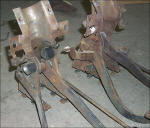
Fig. 1
Left: '67
version
Right: '68 version |

Fig. 2
Left: '67
version
Right: '68 version |
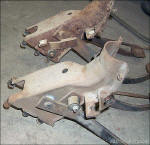
Fig. 3
Top: '67
version
Bottom: '68 version |
|
Dash Knobs and Bezels |
|
The dash
knobs and bezels differ slightly when comparing the '67 versions with
'68 and later versions.
In Fig.
1, you can see the font used on the two lighter bezels is similar, but
the '67 version on the left has a thinner font style. The '70 lighter on
the right has a much bolder font style, plus the silver button center is
sunken in just a bit more.
In Fig. 2,
you can see another comparison. On the left are two choke cable
assemblies. The top version is a '67 and the '68 version on the bottom.
Note the differences in knob thickness and edge details, which is also
obvious in the side view of the two cigarette lighters. Also note the
differences in thread pitch of the choke cables, the different style
retaining nuts and the locating stud on the '68 bezel. |

Fig. 1

Fig. 2 |
|
Ignition Switches |
|
Pictured at
right is a side-by-side comparison of the three different ignition
switch styles used in Ford pickups during the '67-'72 era. On the left
is the '67-only switch, which utilized a single hot stud which protruded
through the push-on connector, which in turn was held on with a small
nut. In the middle is an example of a '68-'70 ignition switch, in which
the harness connector was pushed onto bullet-style connections. The '71-'72 version
on the right, introduced in mid-'70, utilized a similar style but used
spade-type connectors. |

CLICK
THUMBNAIL
TO ENLARGE |
|
Lower Valance Panels |
|
The front
valance panels appear identical for all '67-'72 F-100 thru F-350 trucks,
with one minor exception: The turn signal housings on the '70-'72 trucks
were bolted onto the valance, requiring two holes drilled for them. The
'67-'68 valance panels don't have these holes. However, there are also
some other subtle differences, as shown below.
|
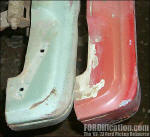
Pictured:
'70-'72 valance panel (left)
'67-'69 valance panel (right) |

Top:
'67 valance panel
Bottom: '70 valance panel
The '67-'69 panels have sharp distinct edges, whereas the '70-'72
panels' edges are softer (more curved). |

Top:
'70 valance panel
Bottom: '67 valance panel
Though it's
not very obvious in this picture, the frame notch is 1/4" wider
on the '70-'72 panels.
. |

Top:
'67 valance panel
Bottom: '70 valance panel
The turn signal area is 1-1/4" wider on the '70-'72 panels. This means
that the later panels will work on '67-'69 trucks, but not vice-versa.
The early panel will not fit the later truck's turn signal indicator,
unless an early grille is also used. |
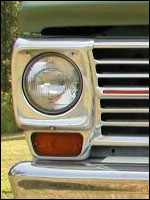
Here's a
shot of a '70-'72 valance panel used with a '69 grille. Notice the extra
space in the valance next to the turn signal indicator... |
...and here's one more. The '70'-72 valance panel
works with the '67-'69 grilles, but with the wider turn signal notches,
it just doesn't look quite right:
 |
|
Upper Valance Panels and
Lower Hood Latch Receivers |
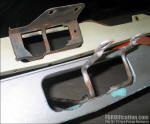 |
There were
two different lower hood latch receivers, which required changes to the
upper valance panel. In the left picture, the '67-'68 latch
receiver is on bottom and the '69-'72 style is on top. You can use an
early-style latch receiver with a later valance, but not vice-versa. The
later receiver will not fit an early valance panel.
(click to
enlarge)
|

Top: '67-'68
Bottom: '69-'72 |
|
Dash Trim |
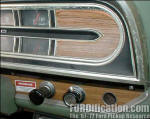 |
1969 was the
first year for woodgrain trim on the dash. The woodgrain trim used on
the dash of the '69 Ranger models differed slightly from that used on
the '70-'72 Ranger and Ranger XLTs. On the left is the '69-only Teakwood
style, while the Burl Walnut style used on the '70-'72 dashes is
pictured at right.
(click to
enlarge)
|
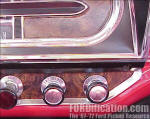 |
|
Hoods |
|


(click
thumbnails to
enlarge) |
The
hood's outer skin is identical on all '67-'72 F100 thru F350
trucks. However, the inner bracing is a little different on the
'67s. The '68-up hoods had an additional hole that the '67s
didn't have (shown at upper left). In addition, the side bracing
is very slightly different (shown at lower left), with the
'68-up hoods having additional supports. Also some '70-up hoods
don't have any of the larger holes along the side bracing, as
shown at lower left. These items wouldn't
matter to anyone who's not doing a 100%-correct restoration.
In
addition, '67 and some early-'68 hoods had a small hood support
bracket with a rubber pad which bolted to the firewall and
supported the rear part of the hood (shown upper right).
Late-'68/later hoods didn't have this bracket, but used an
additional rubber bumper at the trailing edge of the
hood (shown at lower right). |

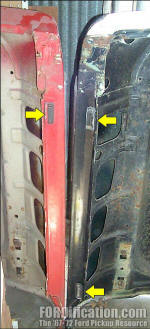
(click
to
enlarge) |
|
NOTE: Apparently, somewhere between unit number
D54817 and D58990 of the '68 model year the factory
ceased using this rear hood support. The graphic at right (which
needs to be updated to reflect the unit numbers listed here)
shows the mounting location and how it was phased out. |

(click
to
enlarge) |
|
Shoulder-belt mounts |
|
Shown in
this picture is the two different locations for the upper shoulder-belt
mount of a 3-point seatbelt setup. The '67-'69 trucks had them located
on the back wall, next to the rear window. The '70-'72 trucks had this
mount moved around to the side panel.
|
 |
|
 |

Want to link to
this site? Please save this banner to your hard drive to place on your
webpage.
The correct link to use is
http://www.fordification.com
|